Unlocking the mysteries of the natural world often leads us to fascinating creatures with extraordinary adaptations. One such creature is the aye-aye (Daubentonia madagascariensis), a long-fingered lemur native to Madagascar. With its rodent-like teeth that continuously grow and a special thin middle finger, the aye-aye stands out among primates.
As the largest nocturnal primate on Earth, the aye-aye showcases its unique foraging technique. It taps on trees, listening for the sound of grubs within, and then uses its forward-slanting incisors to gnaw holes in the wood. With precision and dexterity, it inserts its narrow middle finger to extract the grubs. Known as percussive foraging, this method accounts for a significant portion of the aye-aye’s feeding behavior.
Interestingly, the aye-aye’s feeding strategy parallels that of the woodpecker, as it fulfills a similar ecological niche by penetrating wood to access hidden invertebrates. It shares this specialized foraging technique with only a few other mammals, such as the striped possum and trioks.
Being the sole living member of the genus Daubentonia and family Daubentoniidae, the aye-aye holds a unique position in the natural world. However, its endangered status, classified by the IUCN, reminds us of the need to protect and preserve this remarkable species.
In this article, we will delve deeper into the captivating world of the aye-aye, exploring its habitat, behavior, and conservation status. Join us on this journey as we unravel the enigmatic life of this extraordinary creature and gain a deeper appreciation for the wonders of our natural world.
Overview
| Characteristic | Aye-Aye |
|---|---|
| Scientific Name | Daubentonia madagascariensis |
| Family | Daubentoniidae |
| Type | Mammal |
| Order | Primates |
| Temperament | Nocturnal and solitary |
| Lifespan | Up to 20 years |
| Size | Body length: 14 to 17 inches (36 to 44 cm) |
| Weight | 4 to 6 pounds (2 to 2.7 kg) |
| Diet | Omnivore (feeds on fruits, insects, and seeds) |
| Distribution | Madagascar |
| Habitat | Rainforests and deciduous forests |
| Other names | None |
What’s an aye-aye?
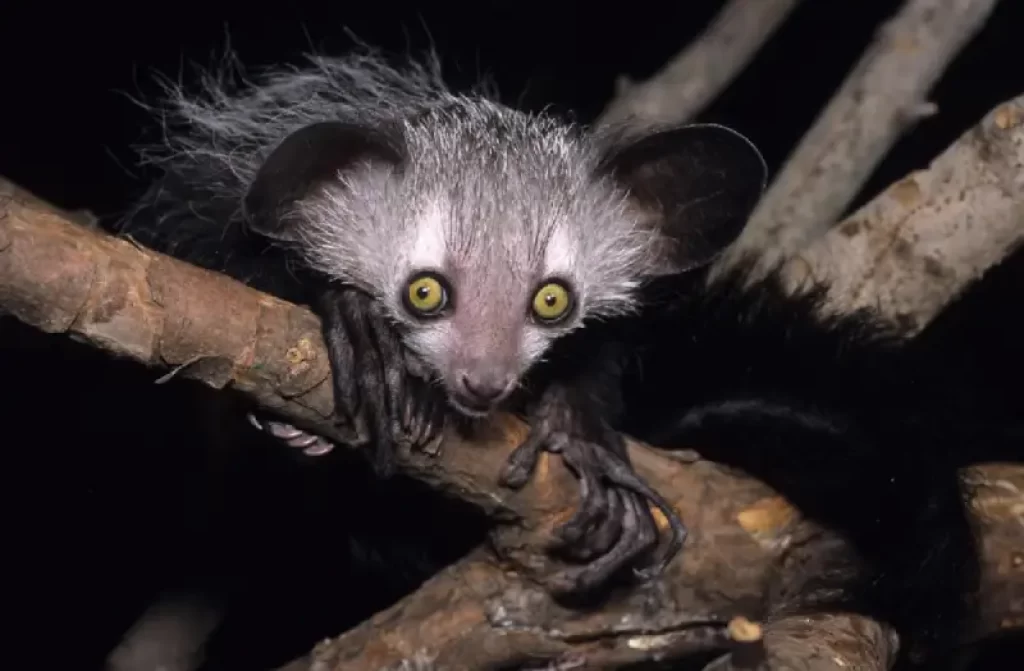
The aye-aye is a unique species of lemur found in Madagascar. It has large ears that help it locate prey at night and large eyes that provide excellent night vision. Its long bushy tail helps it maintain balance while moving through trees, and its sharp claws allow it to climb with ease.
Aye-aye order
Aye-ayes belong to the primate order Primates, which includes lemurs, monkeys, apes, and humans. However, they are classified into their own family called Daubentoniidae.
Is it aye or aye aye?
The correct way to refer to this animal is “aye-aye,” not just “aye.” This name refers specifically to this unique lemur species found in Madagascar.
What is aye aye sir?
“Aye aye sir” is not related to the animal but rather an expression used by sailors or military personnel as acknowledgment of an order given by their superior officer.
Aye-Aye’s Unusual Characteristics: Primate Features and Behaviors
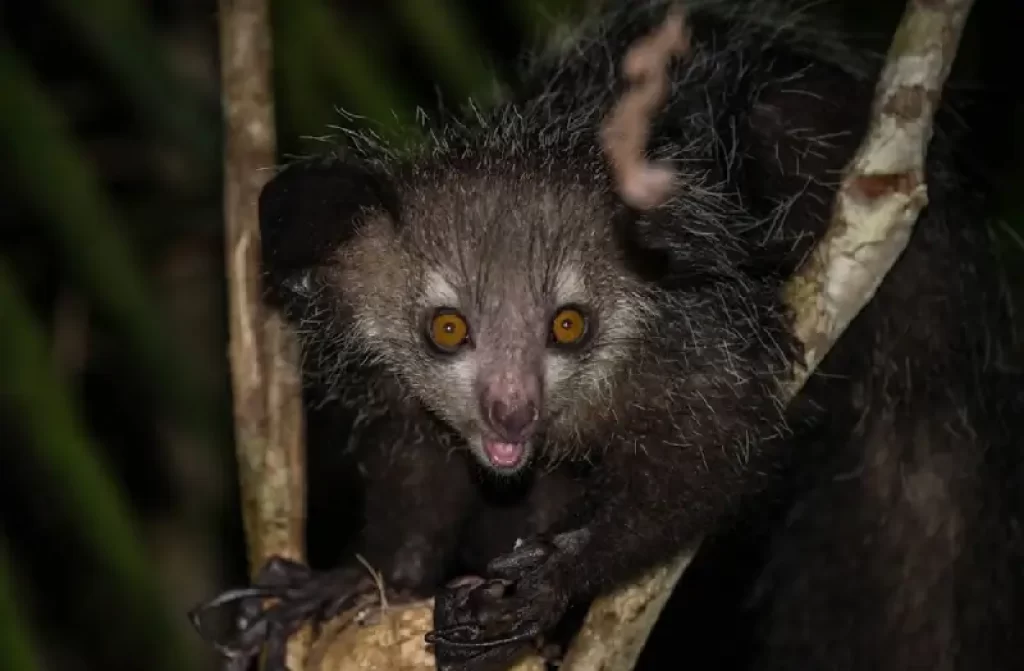
Large Ears: Aye-aye’s Secret to Finding Food
Aye-ayes are known for their unique physical characteristics that set them apart from other primates. One of these features is their large ears, which play a crucial role in helping them locate food. These creatures have an incredible sense of hearing, and their ears serve as amplifiers that allow them to detect even the slightest sounds.
When hunting for insects, aye-ayes use their sharp claws to tap on trees. They then listen carefully for any signs of movement inside the bark. Once they hear something, they use their teeth to gnaw through the wood and extract the insect inside. This tapping behavior is called “duke,” and it is a signature move of the aye-aye.
In addition to helping with hunting, aye-aye’s large ears also help with communication. These creatures make distinct vocalizations that can be heard over long distances thanks to their sensitive ears.
Large Eyes: Aye-Ayes’ Nocturnal Adaptation
Another unique feature of aye-ayes is their large eyes, which aid in nocturnal vision. Unlike many primates that are active during the day, aye-ayes are primarily nocturnal animals. This means they hunt for food at night when insects are most active.
To navigate through pitch-black forests at night, aye-ayes rely heavily on their excellent vision. Their large eyes allow them to see in low light conditions and spot potential prey hiding in trees or on branches.
Continuously Growing Teeth: The Key Ingredient for Aye-Ayes’ Diet
Unlike humans whose teeth stop growing after some time, aye-ayes have continuously growing front teeth throughout their lives. These teeth play an essential role in allowing these creatures to access one of their favorite foods – insects hiding inside tree bark.
Aye-ayes use these sharp front teeth like chisels to gnaw through tough tree bark and extract insects. They also use their teeth to crack open hard-shelled nuts and fruits.
Aye-Aye’s Nocturnal Lifestyle: Diet and Foraging Habits

Diet of Aye-Ayes
Aye-ayes are one of the most unique primates that exist in the world. They are nocturnal animals that spend most of their lives in the dark, foraging for food at night. Their diet mainly consists of insect larvae, but they also eat other types of food such as fruit, nuts, and seeds. Insects make up about 80% of their diet, with larvae being the most preferred type.
Aye-ayes have a unique way of finding their food called percussive foraging. They tap on trees to find insect larvae and grubs hiding inside. Once they locate their prey using echolocation, they use their long middle finger to extract it from the tree trunk or branch. This technique is highly effective and helps them find prey that is hidden deep within trees.
Foraging Habits of Aye-Ayes
Aye-ayes are solitary creatures that live alone in nests made up of leaves and twigs during the day. These nests are hidden away from predators such as birds and larger mammals like leopards or fossas who would easily spot them if they were out in the open.
Their nocturnal lifestyle allows them to avoid detection by predators while searching for food at night. They are known to travel long distances each night in search of food, covering anywhere between 1-3 kilometers per night.
Predators and Protection
The aye-aye’s dark fur helps it blend into its surroundings at night time, making it difficult for predators to detect them while they’re moving around looking for food.
However, despite having some natural protection against predation through camouflaging themselves well at nighttime with their dark fur coloration, aye-ayes still face threats from humans who hunt them for bushmeat or capture them illegally for the pet trade. Habitat loss due to deforestation and agricultural expansion also poses a significant threat to their survival.
Aye-Aye’s Habitat and Distribution: Where to Find Them in Madagascar
Madagascar is known for its unique flora and fauna, including the elusive aye-aye. This species of lemur is scientifically known as Daubentonia madagascariensis and can only be found on this island country in the Indian Ocean off the southeastern coast of Africa.
Where Do Aye-Ayes Live?
Aye-ayes inhabit various types of forests in Madagascar, including rainforests, deciduous forests, and mangrove swamps. They are nocturnal and arboreal animals, meaning they spend most of their time in trees and are active at night. Aye-ayes have long fingers that they use to tap on tree trunks to locate insects hiding inside. Once they find their prey, they use their sharp teeth to gnaw holes into the wood and extract the insects with their thin middle finger.
What Is The Aye-Aye Habitat?
The aye-aye’s habitat includes both primary forests that have not been disturbed by human activity as well as secondary forests that have regrown after being cleared for agriculture or other purposes. However, due to habitat loss caused by deforestation and hunting, aye-ayes are considered an endangered species.
In addition to natural threats like habitat loss, aye-ayes also face persecution from humans who view them as pests or bringers of bad luck. Despite this negative perception among some Malagasy people, others consider aye-ayes to be sacred animals that bring good luck. In some areas of Madagascar, locals even believe that seeing an aye-aye can cure illness or ward off evil spirits.
Threats to Aye-Aye Population: Conservation Status and Efforts
Habitat Loss and Human Encroachment
The aye-aye is a unique lemur species found only in Madagascar. However, their population is threatened due to habitat loss caused by deforestation and human encroachment.
As forests are cleared for agriculture and logging, the aye-aye’s natural habitat shrinks, leaving them with less space to live and hunt for food. This has resulted in the fragmentation of their populations, which makes it difficult for them to breed and survive.
Unauthorized Use of Aye-Aye
Another significant threat to the aye-aye population is the unauthorized use of this animal for traditional medicine and as pets. In some parts of Madagascar, people believe that different parts of the aye-aye’s body possess magical powers that can cure various illnesses.
As a result, they capture these animals from the wild and sell them in local markets. The demand for aye-ayes as pets has also increased over time, leading to further exploitation of this species.
Conservation Efforts
In recognition of these threats, the International Union for Conservation of Nature (IUCN) has listed aye-ayes as an endangered species. Several conservation efforts have been initiated to protect this unique lemur species from extinction.
Habitat Restoration
One such effort is habitat restoration. NGOs like Lemur Love are working towards reforestation programs that aim at restoring degraded forests in Madagascar where the aye-aye lives. These programs involve planting native trees that provide food sources and shelter for not just the aye-aye but other wildlife too.
Captive Breeding Programs
Captive breeding programs have also been established to increase the population numbers of captive-bred individuals before releasing them into protected areas where they can breed with wild populations successfully. For instance, Duke University’s Lemur Center has played an essential role in breeding and researching aye-ayes to increase their population numbers.
Public Awareness Campaigns
Public awareness campaigns are also an integral part of conservation efforts. These campaigns aim to educate people about the importance of protecting the aye-aye and its habitat.
For example, Madagascar’s Ministry of Environment, Ecology, and Forests launched a public awareness campaign called “Mora Mora” that encourages people to take their time and make informed decisions before buying or selling an aye-aye.
Aye-Aye’s Endangered Status: Importance of Protecting the Species
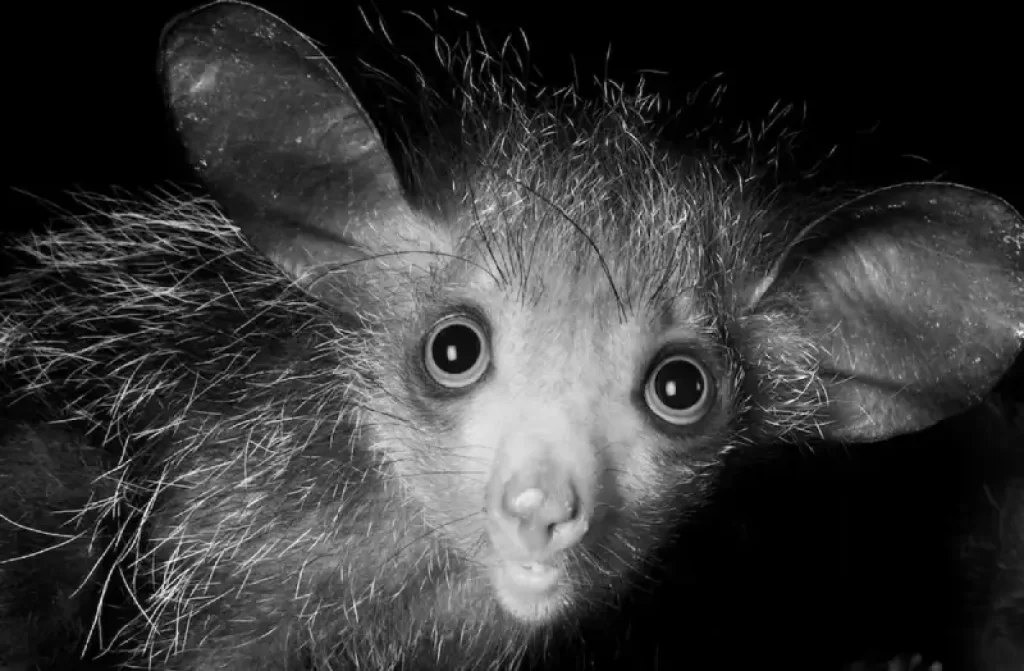
Unique Physical Characteristics: Long Fingers and Guard Hairs
Aye-ayes are fascinating creatures that have unique physical characteristics that set them apart from other primates. One of their most distinctive features is their long fingers, which they use to forage for insects in tree bark. These fingers are so specialized that they have a ball-and-socket joint at the wrist, allowing them to rotate 360 degrees.
Another important physical feature of aye-ayes is their guard hairs. These hairs protect them from the elements and help them blend into their surroundings, making it easier for them to hunt without being detected by predators. The guard hairs also provide insulation, keeping the aye-aye warm during cold nights.
Crucial Role in Ecosystem: Dispersing Seeds and Controlling Insect Populations
Aye-ayes play a crucial role in their ecosystem by dispersing seeds and controlling insect populations. As they forage for insects, they inadvertently spread seeds from the fruits they eat throughout the forest. This helps to ensure that trees continue to grow and thrive in the area.
In addition to seed dispersal, aye-ayes also play an important role in controlling insect populations. They feed on a variety of insects, including beetles, ants, and termites. By consuming these insects, they help keep their populations under control and prevent overgrazing of vegetation.
Endangered Status: Importance of Protecting the Species
Unfortunately, aye-ayes are critically endangered due to habitat loss and hunting. Deforestation has destroyed much of their natural habitat, leaving them with limited areas to live and forage for food. Hunting has further reduced their numbers as many people believe that they bring bad luck or are associated with death.
Protecting aye-ayes is not only important for preserving this unique species but can also benefit other species that share their habitat. Conservation efforts such as habitat restoration and anti-poaching measures are necessary to ensure the survival of aye-ayes. By protecting their habitat and reducing hunting, we can help to increase their numbers and prevent them from becoming extinct.
Aye-Aye’s Social Interactions and Activities: Behavior and Lifestyle
Home Ranges
Aye-ayes are solitary creatures that live in their own home ranges, which can range from 1 to 50 hectares depending on the habitat.
They are arboreal primates that spend most of their time in trees. Their habitats include rainforests, deciduous forests, and mangrove swamps. The aye-aye’s home range is determined by the availability of food resources, shelter, and mates.
Nocturnal Lifestyle
As nocturnal animals, aye-ayes spend most of their time at night searching for food and resting during the day. They are known to be active for up to eight hours each night. During the day, they rest in nests made of leaves and branches high up in trees.
Unique Feeding Behavior
Aye-ayes have a unique way of finding food by tapping on trees with their long middle finger and listening for the sound of insects inside. When they hear an insect moving inside a tree trunk or branch, they use their sharp teeth to gnaw through the bark and extract it with their long thin fingers.
Mating Habits
Mating in aye-ayes occurs once a year when females come into estrus for only one night. Males will compete for access to females during this period by engaging in vocalizations and displays such as tail-waving and head-bobbing. After mating, females give birth to a single offspring after a gestation period of around 160 days.
Conservation Efforts
In their natural habitat, aye-ayes face threats such as habitat loss due to deforestation and hunting for bushmeat or traditional medicine.
However, conservation efforts are being made to protect these unique primates. In some areas like Madagascar’s Analamazaotra Special Reserve or Nosy Mangabe Protected Area, there are programs aimed at conserving aye-ayes by protecting their habitats and monitoring their populations.
Captive Breeding Programs
Captive breeding programs like those at the Duke Lemur Center (DLC) in North Carolina are also working to conserve aye-ayes. The DLC has successfully bred aye-ayes in captivity, which helps to ensure that there is a genetically diverse population of these primates for future generations.
Folk Beliefs and Literature Cited on Aye-Aye
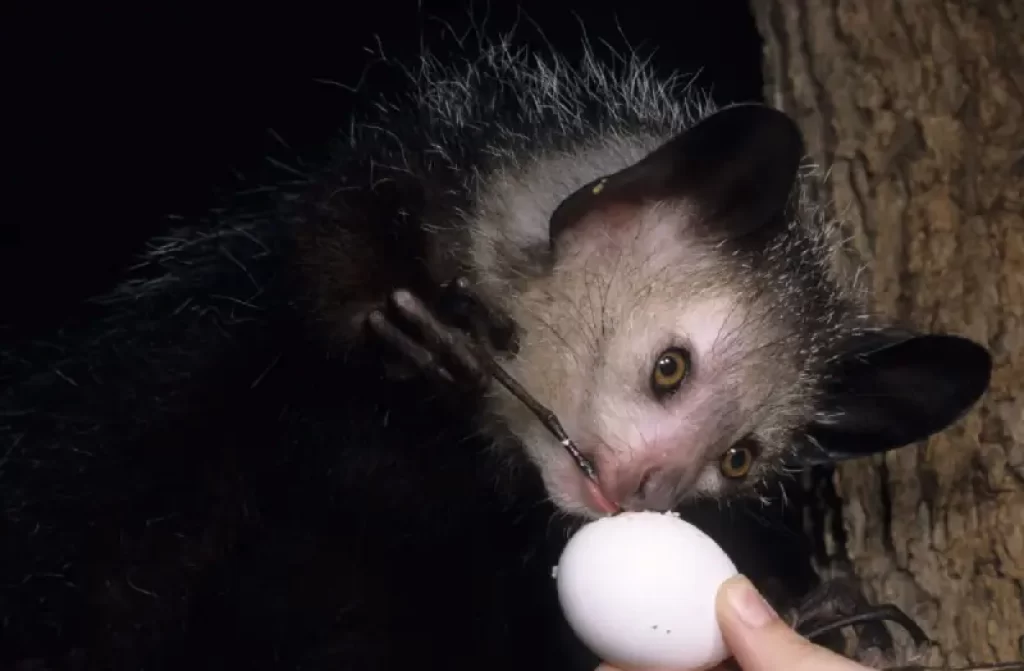
Folk Beliefs: Aye-Ayes as Bad Luck
The aye-aye, a lemur species native to Madagascar, has long been the subject of superstition and fear in local folklore. Many Malagasy people believed that the aye-aye was an omen of death and misfortune. They thought that if they saw an aye-aye, it meant someone in their community would soon die. As a result, aye-ayes were often killed on sight or captured and kept as pets.
However, recent efforts have been made to dispel these myths and educate locals about the importance of preserving this unique animal. Conservation organizations have worked with communities to promote ecotourism centered around observing aye-ayes in their natural habitat.
Nocturnal Creatures: Life in Madagascar’s Forests
Aye-ayes are nocturnal animals that live primarily in the forests of Madagascar. They spend most of their time high up in trees searching for insects using their unique elongated fingers.
In addition to being excellent climbers, aye-ayes also have keen senses of hearing and smell. Their large ears allow them to detect prey moving inside tree bark while their long middle finger acts as an insect probe.
Literature Cited: Famous Adopters & Unique Characteristics
Agatha Christie was one famous adopter of an aye-aye during her travels to Madagascar. She named the lemur Marnie and even wrote a short story featuring the animal.
Aye-ayes have several unique physical characteristics that set them apart from other primates. They are covered in thick, wiry guard hairs that give them a shaggy appearance. These hairs serve as insulation against the cold forest nights.
Their most distinctive feature is their elongated middle finger, which they use to extract insects from tree bark. This finger can be up to three times longer than their other digits and is specially adapted for this task.
Recent research has also shown that aye-ayes play an important role in their ecosystem by helping to disperse seeds. As they move through trees searching for food, they inadvertently drop seeds onto the forest floor, contributing to reforestation efforts.
Interesting Features of Aye-Aye: Fun Facts About the Species
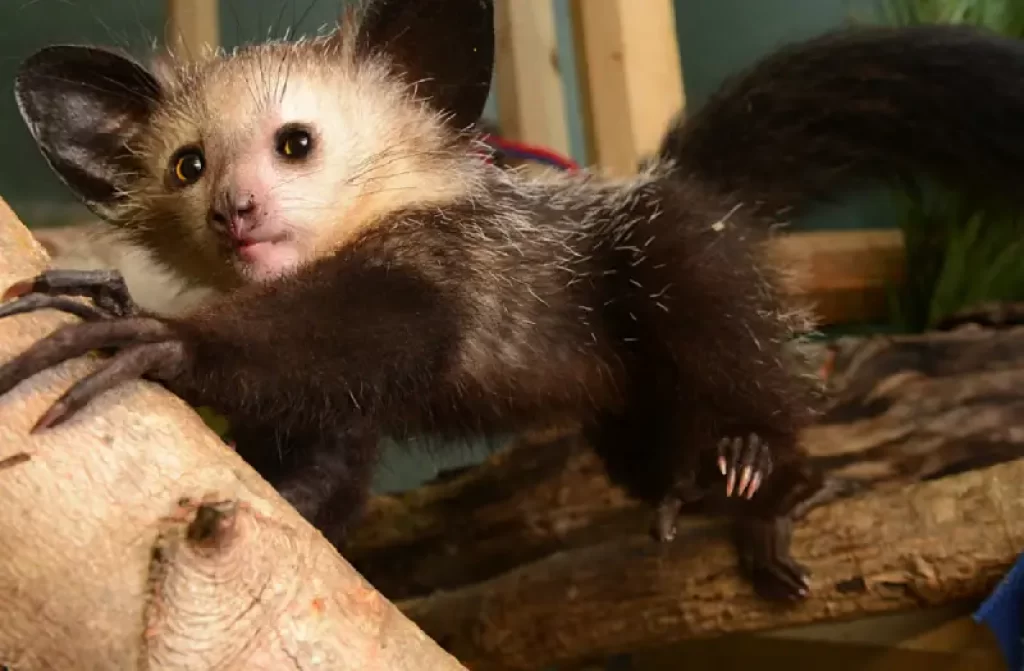
Unique Features of Aye-Aye: Fun Facts About the Species
Male aye-ayes have a unique way of marking their territory by using their long middle finger to tap on trees, creating a distinct sound that can be heard up to 150 meters away.
This method is called “drumming” and is used to communicate with other males and attract females. The tapping sound also helps them locate insects hiding in the bark.
Aye-ayes are nocturnal primates and have large, sensitive ears that help them locate insects hiding in tree bark using echolocation. They use their sharp teeth to gnaw through tough bark and extract insect larvae with their long middle fingers. Their fingers are equipped with an elongated third digit, which they use to probe inside crevices for insects such as grubs, beetles, and spiders.
The aye-aye’s middle finger is not only used for tapping on trees but also for extracting insects from crevices in the bark.
It has a special joint that allows it to bend at a 90-degree angle, making it the perfect tool for this task. This adaptation is crucial since many of the insects they prey upon are hidden deep within tree trunks or branches.
Aye-ayes have continuously growing incisors that never stop growing throughout their lifetime. They use these teeth to gnaw through tough tree bark to get to the insects inside. These incisors grow about 2mm per month, which means they need constant wear-and-tear activities like feeding on hard materials such as wood or nuts.
Despite their unusual appearance, aye-ayes are highly intelligent and have been observed using tools in the wild, such as using sticks to extract insects from crevices. Researchers have observed captive aye-ayes modifying sticks into hooks or forks by stripping off leaves or twigs before inserting them into crevices where insects hide.
Why Aye-Aye is Worth Protecting
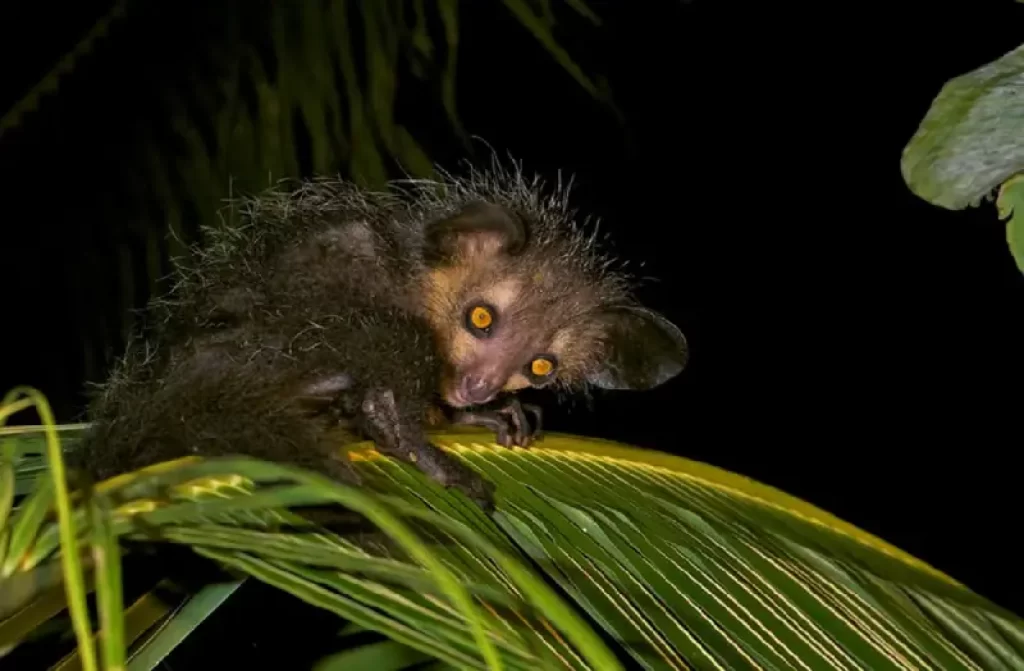
Protecting aye-aye is not just an option, but it is our responsibility as humans to ensure the survival of this unique species. The aye-aye’s unusual characteristics and behaviors make them worth protecting. Their nocturnal lifestyle and foraging habits are fascinating, and their habitat in Madagascar needs to be preserved for future generations.
The aye-aye’s conservation status is threatened due to various factors such as habitat loss, hunting, and superstitions surrounding their existence. It is essential that we take action to protect these primates before it’s too late. We must work towards increasing awareness about the importance of preserving biodiversity in our ecosystem.
Despite being endangered, the aye-aye has been able to maintain social interactions with its own kind and engage in various activities that are unique to their species. Folk beliefs have also played a role in shaping the perception of aye-ayes among people.
Captive breeding programs have been implemented to increase the population of aye-ayes, but more efforts need to be made at both local and international levels. Literature cited on aye-ayes provides valuable insights into their behavior and lifestyle that can help us better understand how we can protect them.
Tags: Aye-AyeMadagascar







